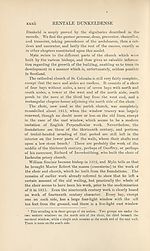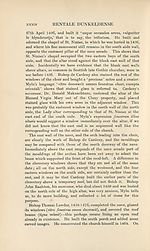Series 2 > Rentale Dunkeldense
(46) Page xxxiii
Download files
Complete book:
Individual page:
Thumbnail gallery: Grid view | List view

DUNKELD CATHEDRAL xxxiii
with the sill some fifteen feet from the ground, leaving a space of
blank wall below of unusual height for the period. The first
bay from the west on the south side has a two-light window of
similar style to the rest. There are modern doorways in this bay,
and in the eastmost bay on the same side where a piscina may
have been destroyed when the wall was broken in 1815. The
third bay on the north side is now occupied by the fifteenth century
chapter-house, though no doubt it had a window originally.
Three sedilia with cinquefoil-headed arches of equal height in the
south wall, some twenty feet from the east end, are clearly the
work of William Sinclair’s time. After referring to the crux
virgata which the bishop placed upon the east gable, and which
has since formed the arms of the Sinclair family, Myln tells us
that ‘ he chose his burial-place at the presbytery step in the midst
of the choir, where his body is buried, covered with a marble
stone; and his effigy of fine alabaster was placed there ; but lest
by any chance it should be destroyed, or should be a hindrance in
front of the altar, during solemn acts or a synod, it has now been
carefully set up close to the steps (ad pedes') of the high altar at
the western part of the north window of the choir.’ Sinclair died
in 1337. His effigy, headless and mutilated, still remains, and
shows the eucharistic vestments of the period, with a full chasuble
of thin material, falling in remarkably beautiful folds. It now
rests in what seems to be the place where Myln tells us it was
afterwards set up, namely, a recess under the eastmost window on
the north side of the choir. This recess is slightly to the west of
the middle of the window, and is sunk back in the wall within
the thirteenth-century arcading, of which a shaft has been
removed, and a bracket substituted to carry the arches over the
recess.
John Peebles, who succeeded in 1396, placed stained glass in
the east window ‘fieri fecit vitream fenestram orientalem chori
Dunkeldensis, diversis ymaginibus vitro albo pictis decoratum.’
Myln’s description of stained glass is not accurate, as applied to
the work of the fourteenth century. Painting upon white glass
was only introduced in the sixteenth century, and was unknown
in John Peebles’ time, when stained glass figures?'were made by
the selection and arrangement of pieces of glass of different
colours and shapes, outlined by the leads, and with drawing and
shading produced by the application and subsequent partial
removal of brown enamel.
His successor, Robert de Cardeny, founded the nave on
with the sill some fifteen feet from the ground, leaving a space of
blank wall below of unusual height for the period. The first
bay from the west on the south side has a two-light window of
similar style to the rest. There are modern doorways in this bay,
and in the eastmost bay on the same side where a piscina may
have been destroyed when the wall was broken in 1815. The
third bay on the north side is now occupied by the fifteenth century
chapter-house, though no doubt it had a window originally.
Three sedilia with cinquefoil-headed arches of equal height in the
south wall, some twenty feet from the east end, are clearly the
work of William Sinclair’s time. After referring to the crux
virgata which the bishop placed upon the east gable, and which
has since formed the arms of the Sinclair family, Myln tells us
that ‘ he chose his burial-place at the presbytery step in the midst
of the choir, where his body is buried, covered with a marble
stone; and his effigy of fine alabaster was placed there ; but lest
by any chance it should be destroyed, or should be a hindrance in
front of the altar, during solemn acts or a synod, it has now been
carefully set up close to the steps (ad pedes') of the high altar at
the western part of the north window of the choir.’ Sinclair died
in 1337. His effigy, headless and mutilated, still remains, and
shows the eucharistic vestments of the period, with a full chasuble
of thin material, falling in remarkably beautiful folds. It now
rests in what seems to be the place where Myln tells us it was
afterwards set up, namely, a recess under the eastmost window on
the north side of the choir. This recess is slightly to the west of
the middle of the window, and is sunk back in the wall within
the thirteenth-century arcading, of which a shaft has been
removed, and a bracket substituted to carry the arches over the
recess.
John Peebles, who succeeded in 1396, placed stained glass in
the east window ‘fieri fecit vitream fenestram orientalem chori
Dunkeldensis, diversis ymaginibus vitro albo pictis decoratum.’
Myln’s description of stained glass is not accurate, as applied to
the work of the fourteenth century. Painting upon white glass
was only introduced in the sixteenth century, and was unknown
in John Peebles’ time, when stained glass figures?'were made by
the selection and arrangement of pieces of glass of different
colours and shapes, outlined by the leads, and with drawing and
shading produced by the application and subsequent partial
removal of brown enamel.
His successor, Robert de Cardeny, founded the nave on
Set display mode to:
![]() Universal Viewer |
Universal Viewer | ![]() Mirador |
Large image | Transcription
Mirador |
Large image | Transcription
Images and transcriptions on this page, including medium image downloads, may be used under the Creative Commons Attribution 4.0 International Licence unless otherwise stated. ![]()
| Scottish History Society volumes > Series 2 > Rentale Dunkeldense > (46) Page xxxiii |
|---|
| Permanent URL | https://digital.nls.uk/127382613 |
|---|
| Attribution and copyright: |
|
|---|
| Description | Over 180 volumes, published by the Scottish History Society, containing original sources on Scotland's history and people. With a wide range of subjects, the books collectively cover all periods from the 12th to 20th centuries, and reflect changing trends in Scottish history. Sources are accompanied by scholarly interpretation, references and bibliographies. Volumes are usually published annually, and more digitised volumes will be added as they become available. |
|---|


